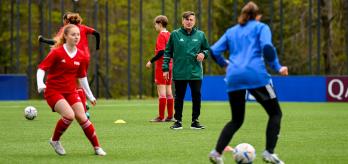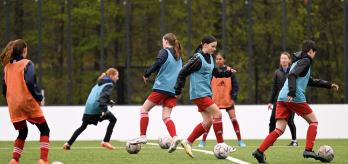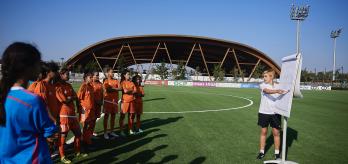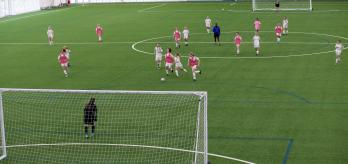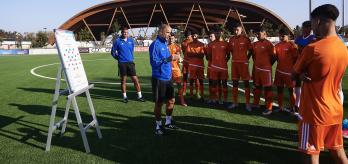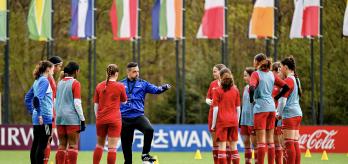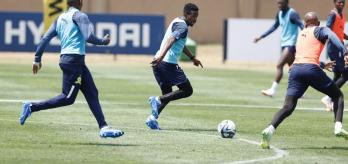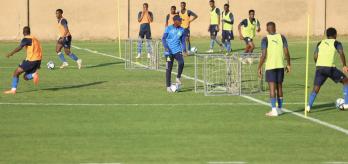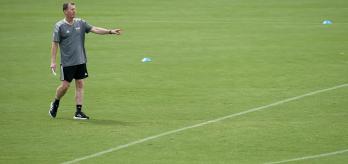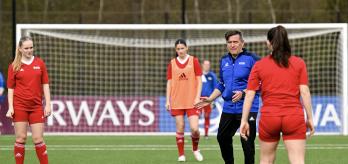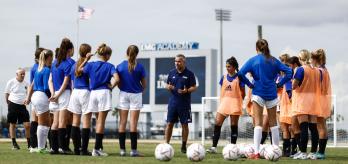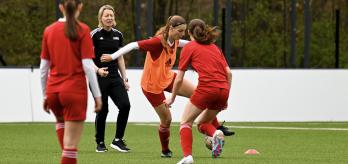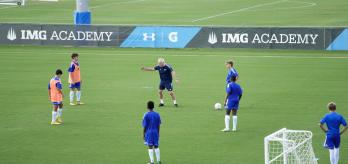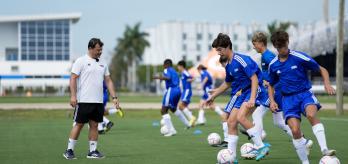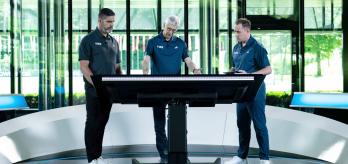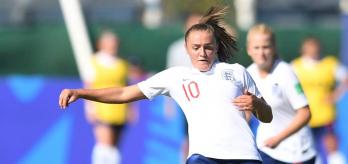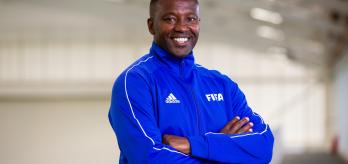Using an open body posture and playing on the half-turn will allow a player to see more of the pitch, maintain greater control of the ball and play in the direction of the available space or an available team-mate. Firm, incisive and well-weighted passes can also allow a team to progress the ball more effectively and avoid oncoming opponents.
In this session, FIFA Technical Expert John Peacock delivers a series of exercises to a group of boys, aimed at improving their skills when passing and receiving. The first exercise works on freely passing and receiving the ball to avoid potential obstacles. Then, a 4v4+3 possession game provides the players with a structure in which they pass and receive the ball. The third exercise also involves a 4v4+3 but restricts the players to certain areas when building the play. The session finishes with a 5v5+1 in which players must build attacks using a central player.
Session overview
Key coaching points
-
Before receiving the ball, players should scan their surroundings to identify the available space and avoid playing into oncoming opponents.
-
Players should open up their bodies and play on the half-turn to give themselves multiple passing options and progress the ball more effectively.
-
Well-weighted and well-timed passes help prevent heavy touches or interceptions, allowing players to play quickly and keep possession.
-
A quality first touch away from oncoming opponents allows players to keep the ball and play into space.
Part 1: Pass, move and receive to avoid congested areas
This first exercise focuses on the fundamentals of passing and receiving to play around obstacles and avoid congested areas. The players must be spatially aware and must accurately weight and time their passes and take controlled first touches.
-
Mark out a 30x30m area.
-
Split 16 players into pairs.
-
Give each pair a ball.
-
Each pair must pass the ball back and forth between each other whilst on the move.
-
The players must use one or two touches.
-
The players cannot leave the area.
-
The players must avoid other players as they pass and move.
-
Four of the players become defenders and must press passively to apply some pressure. If they can steal the ball, they can do.
-
Delay the pass if the area a team-mate is moving into is congested or if the passing lane has obstacles.
-
Accurately weight the passes so that they are not played too firmly, making them difficult to control, or too softly, making them easy to intercept.
-
Scan and check to identify the available space whilst using an open body posture to move into the space smoothly.
-
A good first touch out of the feet is key to setting up a passing lane or an angle for a return pass and allows players to move the ball away from their opponents in a match-like scenario.
-
When under pressure from an opponent, players should use an arm to hold them off and maintain close control of the ball.
-
Encourage the players receiving the ball to be creative with their touches, helping to avoid opponents and change direction quickly.
Part 2: Possession game (4v4+3)
This possession game focuses on using numerical advantages to progress the ball quickly. Players must take an excellent first touch into space and play firm, incisive passes to progress from one end of the area to the other.
-
Mark out a 30x25m area.
-
Split the group into two teams of four (blue and orange) and one team of three (green).
-
Set up the green team so that they have a player at each end of the area and a player inside the area.
-
Position the four orange players on the edge of the area, with two on each side.
-
Position the four blue players inside the area.
-
The green team are neutral and can play with the team in possession.
-
The ball starts with one of the green players at either end of the area.
-
The ball must be played from one end to the other, with the orange team keeping possession.
-
The orange team must combine with the green player inside the area to progress the ball.
-
The blue team must try to block passes and win the ball.
-
If the blue team win the ball, they swap positions with the orange team, who enter the area and try to win the ball back.
-
The teams now compete inside the playing area and play in opposite directions.
-
The teams can now score a point by moving the ball from one end to the other.
-
When progressing the ball, players must consider the best possible pass they can play, whilst identifying the space and the position of their opponents.
-
Take touches away from congested areas and find team-mates in space.
-
Play firm and incisive passes into team-mates so that the ball can be moved quickly and to prevent the opposition from having time to apply pressure.
-
The team in possession should always have a numerical advantage and should always find the player who is free.
Part 3: Possession game with fixed positions (4v4+3)
This exercise focuses on quality passing and receiving. The players must scan their surroundings and use an open body posture to progress the ball, and quick and firm passes are essential.
-
Mark out a 20x20m area and divide it into four squares.
-
Mark out a small 3x3m space in the middle of the area using cones.
-
Split the group into two teams of four (green and orange) and a team of three (blue).
-
Position one blue player at either end of the area and one inside the small 3x3m space in the middle.
-
Position one green and one orange player in each of the four squares.
-
The ball starts with one of the blue players at either end of the area.
-
The green team play from left to right and the orange team play from right to left.
-
The team in possession must combine with the neutral players to play from one end of the area to the other.
-
The green and orange players must stay inside their designated squares.
-
The blue player in the small space in the middle of the area cannot be tackled.
-
Teams score one point if they successfully progress the ball from one end of the area to the other.
-
Increase the difficulty of the exercise by making the area smaller so that the players have less space in which to operate.
-
Players should maintain an open body posture when receiving the ball, as it allows them to play in multiple directions and identify the progressive passes available to them.
-
Players should decide when to move inside or into a wide position to open up passing lanes for team-mates.
-
The central player must play on the half-turn, as this will enable them to progress the ball towards the opposite end more effectively.
-
Players must constantly scan their surroundings to identify the space and locate their team-mates before receiving the ball.
-
Encourage players to play one-touch where possible, especially when the target man is open.
-
Defenders must alter their position and occupy the space between receiving players to block off passing lanes and make it more challenging for the opposition to progress the ball.
-
When under pressure, players can use turns and feints to deceive opponents and open up passing lanes.
Part 4: Attack v. defence (5v5+1)
The final game puts into practice the main aspects of the previous exercises. Incisive passing, excellent spatial awareness, movement off the ball and an open body posture are essential for teams to build from the back and create attacks.
-
Mark out a 40x30m pitch with a full-size goal and a goalkeeper at each end.
-
Mark out a 5m space in the middle of the pitch between the two end zones.
-
Split the players into two teams of five, with one neutral player.
-
Position three defenders and two attackers in each end zone.
-
Position the neutral player inside the 5m space between the two end zones.
-
The ball starts with either goalkeeper, who must pass to one of the defenders.
-
The team in possession must build and progress the play by playing passes to the neutral player or into their attacking team-mates in the other end zone, who must try to score.
-
Players must stay inside their respective zones.
-
If the neutral player receives the ball, they must look to find one of the attackers.
-
The attackers can pass back to the neutral player if they need to.
-
When out of possession, the two attackers must press their opponents and try to win the ball back, whilst the defenders must stop the attackers from scoring.
-
If the ball is intercepted or possession changes hands, play continues but in the opposite direction.
-
The players should use the full width of the area when their team are in possession so that the opposition cannot congest the middle.
-
Offer passing lanes with an open body posture to help the team to play forwards.
-
The players should try to always be on the move inside their respective zones to create space for themselves and their team-mates to receive a pass.
-
The central neutral player should be used as a link between defence and attack, whilst passes into them should be quick and firm.














